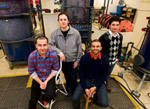
Award-winning project from four Ryerson University chemical engineering students claims to remove 90 percent of pharmaceuticals and endocrine-disrupting compounds.
Silicon Valley Toxics Coalition in California, using self-reported data, ranked German manufacturers highest of the 14 companies that responded.
An Institute for Energy and Environment Research report notes that France uses less than 1 percent of the natural uranium resource and has higher waste volume.
The water treatment company specializes in operating systems for cooling towers and evaporative condensers.
California Superior Court said the South Coast Air Quality Management District's Rule 1143, which would set a volatile organic compound limit on solvents, would require manufacturers to produce extremely flammable products.
N.J. real estate developer plans to cut energy and water use on its properties across the state.
A Phoenix wastewater treatment plant provides treated effluent that is further treated to cool Palo Verde Nuclear Generating Station for homes in Glendale, Mesa, Phoenix, Scottsdale, and Tempe.
The Lead Renovation, Repair and Painting Rule goes into effect on April 22.
EPA says new label requirements also should lower the potential for accidental poisonings.
The Off-Highway Motor Vehicle Recreation Division is requesting statements of qualifications for environmental regulatory compliance contracts by April 21.
The city and county expect to use the funds for community outreach, compact fluorescent and LED bulbs as well as energy audits.

The Arizona State Prison in Pima County installed a system that uses compressed air to break down fats, oils, and grease in a sewage lift station.

An environmental journalist makes a UNEP-sponsored field visit to Mariakani to see first hand how scarce fresh water is and how that affects the people of the village.
The research grants will support studies on allergy risks, wildfires and public health, and vehicle technologies.
Severn Trent Services' system will dramatically reduce nutrient discharges from the Patapsco Wastewater Treatment Plant into the Chesapeake Bay.
More than 15 companies received between $46,000 and $70,000 from EPA to apply toward innovative technologies.